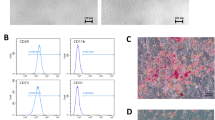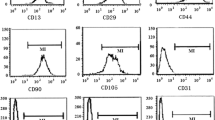Abstract
P53 is shown recently to play an important role in the proliferation and differentiation of mesenchymal stem cells. In this study, human umbilical cord derived mesenchymal stem cells (hUCMSCs) were isolated and purified from the umbilical cords of normal or cesarean term deliveries, after treatment with 20 μmol/L PFT-α for 24 h, hUCMSCs were continued to be cultured for 4 weeks, cardiac-specific protein expression of cTnI, Desmin and Nkx2.5 was determined using immunofluorescence assay and RT-PCR. The expression of p53 and p21 was detected by western blot. Results showed that no expression of cTnI, Desmin or Nkx2.5 was observed in the control and the PFT-α group at 1 week after induction. However, after 4 weeks, while control group still had little expression of cTnI, Desmin and Nkx2.5, the PFT-α group demonstrated strong expression of cTnI, Desmin and Nkx2.5 (P < 0.001). At 4 weeks after induction, differentiation rate of cardiomyogenic cells in the PFT-α group (36.98 %) was significantly higher than that in the control group (4.41 %) (P < 0.01). Western blot analysis show that downregulation of p53 and p21 was seen in the PFT-α group at 4 weeks. The difference compared with the control group was statistically significant (P < 0.01). In conclusion, PFT-α can promote the differentiation of hUCMSCs into cardiomyogenic cells by modulating the p53–p21 pathway.






Similar content being viewed by others
References
Armesilla DA, Elvira G, Silva A (2009) P53 regulates the proliferation, differentiation and spontaneous transformation of mesenchymal stem cells. Exp Cell Res 315:3598–3610
Begum RA, Farah IO, Ishaque AB (2002) Pifithrin-alpha (PFT-alpha) caused differential protection of rat liver cells and HepG2 cell line in response to the selective cytotoxicity of arsenic and cadmium. Biomed Sci Instrum 38:41–46
Cao F, Sun D, Li C, Narsinh K, Zhao L, Li X, Feng X, Zhang J, Duan Y, Wang J, Liu D, Wang H (2009) Long-term myocardial functional improvement after autologous bone marrow mononuclear cells transplantation in patients with ST-segment elevation myocardial infarction: 4 years follow-up. Eur Heart J 30:1986–1994
Chabannes D, Hill M, Merieau E, Rossignol J, Brion R, Soulillou JP, Anegon I, Cuturi MC (2007) A role for heme oxygenase-1 in the immunosuppressive effect of adult rat and human mesenchymal stem cells. Blood 110:3691–3694
Delalat B, Pourfathollah AA, Soleimani M, Mozdarani H, Ghaemi SR, Movassaghpour AA, Kaviani S (2009) Isolation and exvivo expansion of human umbilical cord blood-derived CD34 + stem cells and their cotransplantation with or without mesenchymal stem cells. Hematology 14:125–132
Gandia C, Bartual M, Garcia-Verdugo JM (2009) Cardiac differentiation is driven by NKX2.5 and GATA4 nuclear translocation in tissue-specific mesenchymal stem cells. Stem Cells Dev 18:907–918
Gary RK, Jensen DA (2005) The p53 inhibitor pifithrin-α forms a sparingly soluble derivative via intramolecular cyclization under physiological conditions. Mol Pharm 6:462–474
Gen SW (2004) The functional interactions between the p53 and MAPK signaling pathways. Cancer Biol Ther 32:156–161
Hong H, Takahashi K, Ichisaka T (2009) Suppression of induced pluripotent stem cell generation by the p53–p21 pathway. Nature 460:1132–1136
Inoue Y, Tomiya T, Nishikawa T, Ohtomo N, Tanoue Y, Ikeda H, Koike K (2013) Induction of p53-dependent p21 limits proliferative activity of rat hepatocytes in the presence of hepatocyte growth factor. PLoS ONE 8:e78346
Janssens S, Dubois C, Bogaert J, Theunissen K, Deroose C, Desmet W, Kalantzi M, Herbots L, Sinnaeve P, Dens J, Maertens J, Rademakers F, Dymarkowski S, Gheysens O, Van Cleemput J, Bormans G, Nuyts J, Belmans A, Mortelmans L, Boogaerts M, Van de Werf F (2006) Autologous bone marrow-derived stem-cell transfer in patients with ST-segment elevation myocardial infarction: double-blind, randomised controlled trial. Lancet 367:113–121
Méndez-Ferrer S, Michurina TV, Ferraro F, Mazloom AR, Macarthur BD, Lira SA, Scadden DT, Ma'ayan A, Enikolopov GN, Frenette PS (2010) Mesenchymal and haematopoietic stem cells form a unique bone marrow niche. Nature 466:829–834
Misra UK, Pizzo SV (2010) PFT-α inhibits antibody-induced activation of p53 and pro-apoptotic signaling in 1-LN prostate cancer cells. Biochem Biophys Res Commun 391:272–276
Nishikawa R, Anada T, Ishiko-Uzuka R, Suzuki O (2014) Osteoblastic differentiation of stromal ST-2 cells from octacalcium phosphate exposure via p38 signaling pathway. Dent Mater J 33:242–251
Pereira WC, Khushnooma I, Madkaikar M, Ghosh K (2008) Reproducible methodology for the isolation of mesenchymal stem cells from human umbilical cord and its potential for cardiomyocyte generation. J Tissue Eng Regen Med 2:394–399
Taylor MR, Slavov D, Ku L, Di Lenarda A, Sinagra G, Carniel E, Haubold K, Boucek MM, Ferguson D, Graw SL, Zhu X, Cavanaugh J, Sucharov CC, Long CS, Bristow MR, Lavori P, Mestroni L, Familial Cardiomyopathy Registry, BEST (Beta-Blocker Evaluation of Survival Trial) DNA Bank (2007) Prevalence of Desmin mutations in dilated cardiomyopathy. Circulation 115:1244–1251
Turan RG, Bozdag-T I, Ortak J, Kische S, Akin I, Schneider H, Turan CH, Rehders TC, Rauchhaus M, Kleinfeldt T, Belu C, Brehm M, Yokus S, Steiner S, Sahin K, Nienaber CA, Ince H (2011) Improved functional activity of bone marrow derived circulating progenitor cells after intra coronary freshly isolated bone marrow cells transplantation in patients with ischemic heart disease. Stem Cell Rev Rep 7:646–656
Walton MI, Wilson SC, Hardcastle IR, Mirza AR, Workman P (2005) An evaluation of the ability of pifithrin-α and -β to inhibit p53 function in two wild-type p53 human tumor cell lines. Mol Cancer Ther 9:1369–1377
Wollert KC, Meyer GP, Lotz J, Ringes-Lichtenberg S, Lippolt P, Breidenbach C, Fichtner S, Korte T, Hornig B, Messinger D, Arseniev L, Hertenstein B, Ganser A, Drexler H (2004) Intracoronary autologous bone marrow cell transfer after myocardial infarction: the BOOST randomised controlled clinical trial. Lancet 364:141–148
Wu CX, Zhang EY, Yang SY, Ma JY, An Q, Shi YK (2008) The expression of GATA-4 and Nkx2. 5 gene in the transformation of rattus mesenchymal stem cells into cardiomyocytes [In Chinese]. Sichuan Da Xue Xue Bao Yi Xue Ban 39:882–885
Conflict of interest
None.
Author information
Authors and Affiliations
Corresponding author
Rights and permissions
About this article
Cite this article
Ruan, ZB., Zhu, L., Yin, YG. et al. Inhibitor of p53–p21 pathway induces the differentiation of human umbilical cord derived mesenchymal stem cells into cardiomyogenic cells. Cytotechnology 68, 1257–1265 (2016). https://doi.org/10.1007/s10616-015-9886-5
Received:
Accepted:
Published:
Issue Date:
DOI: https://doi.org/10.1007/s10616-015-9886-5




